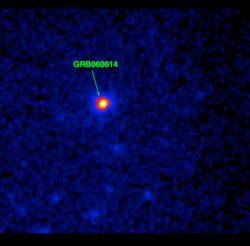 Just when you thought you’d figured out all the ways to blow up, nature reveals a new way. This latest class of explosion is called a hybrid gamma-ray burst, and it was discovered by NASA’s Swift satellite. As with most gamma-ray bursts, this explosion probably indicates the birth of a new black hole in the Universe; however, the explosion itself was different from what astronomers have seen before.
Just when you thought you’d figured out all the ways to blow up, nature reveals a new way. This latest class of explosion is called a hybrid gamma-ray burst, and it was discovered by NASA’s Swift satellite. As with most gamma-ray bursts, this explosion probably indicates the birth of a new black hole in the Universe; however, the explosion itself was different from what astronomers have seen before.
Continue reading “Here’s a New Way to Explode: Hybrid Gamma-Ray Burst”
Happy Hubble Holidays
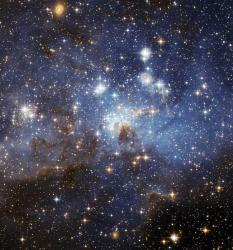 The fine folks at the Hubble Space Telescope released this photograph today to celebrate the holidays. I’m not sure which holiday specifically, but anytime is a good time to release beautiful new photographs from Hubble.
The fine folks at the Hubble Space Telescope released this photograph today to celebrate the holidays. I’m not sure which holiday specifically, but anytime is a good time to release beautiful new photographs from Hubble.
Continue reading “Happy Hubble Holidays”
How Multiple Star Systems Come Together
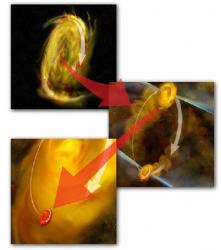 Multiple star systems are a staple of science fiction. The heroes stumble across a parched desert searching for some escape from the three suns burning in the sky. As they struggle for their lives, perhaps our protagonists might take a moment to consider the chain of astronomical events that brought them to this moment.
Multiple star systems are a staple of science fiction. The heroes stumble across a parched desert searching for some escape from the three suns burning in the sky. As they struggle for their lives, perhaps our protagonists might take a moment to consider the chain of astronomical events that brought them to this moment.
Continue reading “How Multiple Star Systems Come Together”
Spitzer Looks Right Back to the First Stars
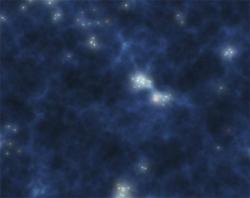 After the Big Bang there were the first stars. Astronomers think these monsters contained more than 1,000 times the mass of our Sun, and poured out torrents of radiation. They didn’t last long, but they began the cycles of star birth, death, and detonation that helped to create the Universe as we see it today; as well as all the heavier elements.
After the Big Bang there were the first stars. Astronomers think these monsters contained more than 1,000 times the mass of our Sun, and poured out torrents of radiation. They didn’t last long, but they began the cycles of star birth, death, and detonation that helped to create the Universe as we see it today; as well as all the heavier elements.
Continue reading “Spitzer Looks Right Back to the First Stars”
Star Formation Factory
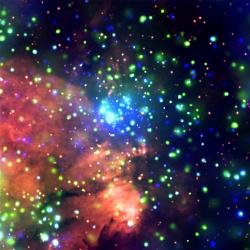 You’re looking at a star forming region known as W3. It’s located about 6,000 light-years from Earth in the Perseus arm of the Milky Way. It’s just a small part of a much larger molecular cloud complex called the W4 superbubble (not pictured here), which extends about 100 light-years across. As that superbubble expands, it’s giving these clouds of dust and gas just the bump they need to collapse and get down to the business of furious star formation.
You’re looking at a star forming region known as W3. It’s located about 6,000 light-years from Earth in the Perseus arm of the Milky Way. It’s just a small part of a much larger molecular cloud complex called the W4 superbubble (not pictured here), which extends about 100 light-years across. As that superbubble expands, it’s giving these clouds of dust and gas just the bump they need to collapse and get down to the business of furious star formation.
Continue reading “Star Formation Factory”
New Technique Could Reveal Dark Matter
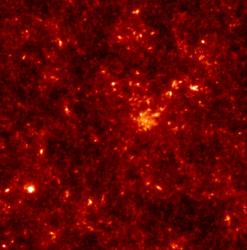 Dark matter is invisible to all our instruments, but that doesn’t mean it isn’t there. It does reach out to regular matter with its gravity. A new technique being developed at the Max Planck Institute for Astrophysics might be able to make dark matter reveal itself. A large enough radio telescope should be able to map the radiation from pregalactic hydrogen – formed shortly after the big bang, and visible in all directions. Any intervening dark matter will distort this radiation, like ripples in a pond, revealing its presence and quantity.
Dark matter is invisible to all our instruments, but that doesn’t mean it isn’t there. It does reach out to regular matter with its gravity. A new technique being developed at the Max Planck Institute for Astrophysics might be able to make dark matter reveal itself. A large enough radio telescope should be able to map the radiation from pregalactic hydrogen – formed shortly after the big bang, and visible in all directions. Any intervening dark matter will distort this radiation, like ripples in a pond, revealing its presence and quantity.
Continue reading “New Technique Could Reveal Dark Matter”
Heavy Stars Embedded in NGC 6357
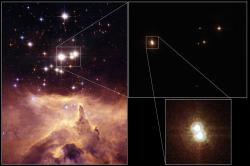 This Hubble photograph shows star cluster Pismis 24, which lies at the heart of emission nebula NGC 6357. The stars are some of the most massive ever seen in our galaxy, each of which weighs at least 100 times the mass of our Sun. Astronomers originally thought it was two stars, each of which exceeded the theoretical limits on stellar size. Hubble discovered that it’s actually three stars, bringing the reality back in line with theory.
This Hubble photograph shows star cluster Pismis 24, which lies at the heart of emission nebula NGC 6357. The stars are some of the most massive ever seen in our galaxy, each of which weighs at least 100 times the mass of our Sun. Astronomers originally thought it was two stars, each of which exceeded the theoretical limits on stellar size. Hubble discovered that it’s actually three stars, bringing the reality back in line with theory.
Continue reading “Heavy Stars Embedded in NGC 6357”
What Makes the Biggest Impact on Galactic Evolution?
Astronomers assume that the galaxies we see today are the result of billions of years of evolution. Collision after collision turned small, irregular galaxies into majestic spirals like our Milky Way. But does the evolution depend on starting conditions, or is it all about the galactic collisions? A recent survey of more than 6,500 galaxies at various distances shows the environment of the early Universe made a significant impact on the evolution of the galaxies we see today. So both the early environment and ongoing collisions played a part.
Continue reading “What Makes the Biggest Impact on Galactic Evolution?”
Supermassive Black Hole Mashes Up and Consumes a Star
A supermassive black hole in a distant galaxy has been caught in the act of consuming a star. In fact, NASA’s Galaxy Evolution Explorer was able to watch the entire process, from the beginning to the end. A some point in the recent past, a star got too close to the supermassive black hole, and was torn apart. The shreds swirled around the black hole, and the Galaxy Evolution Explorer spotted the bright blast of ultraviolet light.
Continue reading “Supermassive Black Hole Mashes Up and Consumes a Star”
First Negatively Charged Space Molecules Discovered
Until now, all the molecules discovered in space were either neutral or positive in charge. But astronomers have turned up a rare negative molecule called C6H-. Molecules like this are thought to be extremely rare in space, because the ultraviolet light radiated from stars easily knocks electrons off molecules, changing their polarity. The molecule was discovered in the vicinity of two nebulae by the Robert C. Byrd Green Bank Telescope.
Continue reading “First Negatively Charged Space Molecules Discovered”
